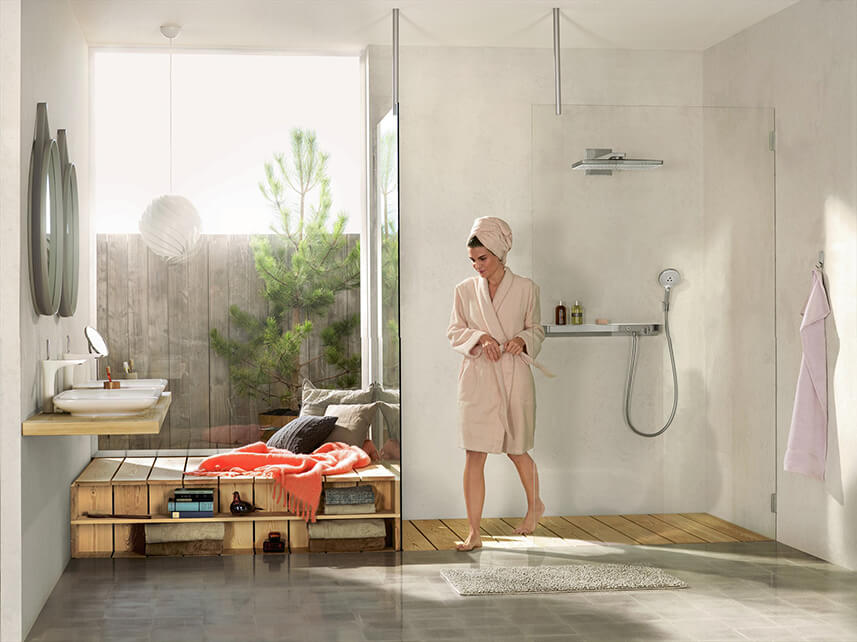- 4 Comment(s)
- /
Planning your dream spa shower is more than just determining style, colour scheme, finishes, and features. One of the most important decisions you will make is whether you want to install a Thermostatic or Pressure-Balancing shower valve. Many consumers aren’t clear about what the differences are between these two shower types. Let’s take a look at what sets a Thermostatic Shower apart from a Pressure-Balancing Shower, the benefits of a thermostatic shower and some brands who manufacture Thermostatic Showers.
Thermostatic shower vs. Pressure-Balancing Shower: What’s the Difference?
Pressure-Balancing Shower
The pressure-balancing shower valve was the first significant departure from the two-handle shower valve. These primitive valves could produce water at temperatures exceeding 140F - well above that known to cause injury. Even when the user adjusted the temperature to their comfort level, cold water drawn from another fixture limited that produced by the shower valve - causing a sudden and persistent flow of scalding water to douse the user.
Pressure-balancing valves eliminated this problem in two simple ways. Firstly, they can be installed so that they cannot be adjusted to produce scalding water. Second, and most importantly, they contain a mechanism called a pressure-balancing spool. When another fixture draws water, the spool moves - controlling the flow of hot or cold water. Pressure balancing technology has existed for many years, but water temperature control provisions did not appear in the Canadian National Plumbing Code until 2001.
Safer and more comfortable than their predecessor, pressure balancing valves are a reliable and cost-effective option and can be outfitted in a wide variety styles and finishes
Thermostatic Shower
Thermostatic showers provide consumers with peace of mind when it comes to the temperature of their shower. This shower works by constantly making slight adjustments to changes in water pressure, in order to ensure that you receive a consistent and even shower temperature. Additionally, thermostatic showers produce greater flow rates than conventional pressure-balancing showers - necessary to those considering multiple body spray options.
When you turn the tap on, the settings will instantly deliver your desired temperature.
Pros and Cons of a Thermostatic vs. Non-Thermostatic Shower
|
Thermostatic Shower |
Non-Thermostatic Shower |
|
|
Pros |
|
|
|
Cons |
|
|
Thermostatic Shower Options In Stock:
- Brizo - http://plumbingonline.ca/products/brizo-t60210-rb - Brizo’s thermostatic shower in Venetian Bronze gives a touch of traditional elegance to your spa shower
- Grohe - http://plumbingonline.ca/products/grohe-19928000 - the geometric lines of Grohe’s Eurocube GroheFlex custom shower is a perfect choice to complement modern bathroom design.
- Hansgrohe - http://plumbingonline.ca/products/hansgrohe-10751001 - Add volume control to your modern, thermostatic shower with Hansgrohe
- Kalia - http://plumbingonline.ca/products/kalia-bf1180-110 - the modern geometric finishes of Kaila’s Umani Collection Thermostatic Shower create an in-home experience that makes a statement.
- Moen - http://plumbingonline.ca/products/moen-s3384 - when you’re looking for the ultimate in spa shower experiences you will want to take a closer look at Moen’s i-oDigital ® Thermostatic Shower technology.
Many consumers are choosing to install a Thermostatic Shower in their spa bathroom, in order to achieve their great benefits. With a wide selection of styles, and finishes available you are sure to find the Thermostatic Shower that suits your budget and design aesthetic at Plumbing Online Canada.

Comments
Kenneth255 on
The pressure-balancing shower valve was the first significant departure from the two-handle shower valve.
Kenneth255 on
Pressure balancing the shower is valve is sensitive and when fix the valve carefully and doing the work by professional plumber.
PlumbingOnline.ca Customer Support on
Hi Brian.
To make the adjustment you seek, please see Step 7 on Page 18 of this handy guide from Kalia:
https://www.kaliastyle.com/files/guide/104786.pdf
I hope this helps – thanks for shopping at PlumbingOnline.ca.
Sincerely,
Kevin
PlumbingOnline.ca Customer Support
Brian Champlin on
How do I adjust the anti-scald or high temperature limit on a kalmia thermostatic mixing valve?
The shower is hot initially then the mixing valve kicks in and it’s only warm after that.
Thanks
Brian